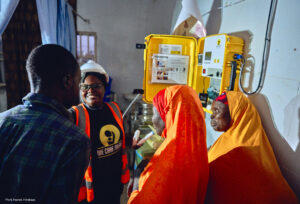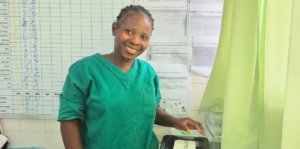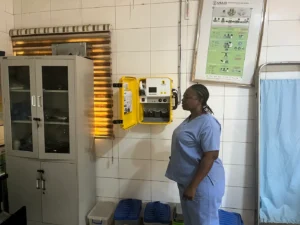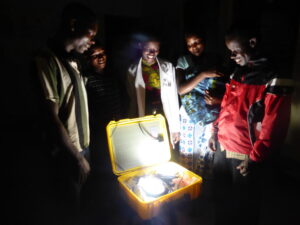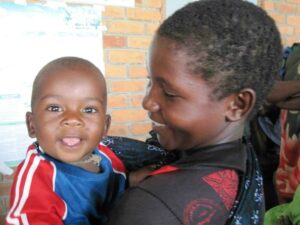I arrived at the hospital today and was warmly received by the medical director and hospital staff. I met with the operating theatre team and brought in the six boxes of supplies that I transported. We opened each box, and marvelled at the lights, two-way radios, antennas, and repeater. Everything made it in good condition! I described the new radio system that Tom Ohlsson designed, and talked about my desire to partner with hospital staff on an evaluation of the new equipment. I had sent several surveys to hospital staff via the medical director ahead of my arrival, but wasn’t surprised when I learned that these were not completed. I knew that it was unlikely to get people to fill out the surveys without my direct explanation and urging.
After the warm reception from the OR crew, I made my way to the maternity ward, and embraced the nurses with whom I had bonded last summer. Within minutes, I was swept into the drama of the place – the ward filled with mothers, babies and family members, the labor room, which had three obstetric emergencies at once, the post-partum patients needing blood transfusions and antibiotics. The sights, sounds and smells were so familiar to me.
I was reminded today of the urgency of this project. All three of the patients in the labor room needed emergency c/sections. One was a woman having her seventh pregnancy whose baby was in an abnormal position. The face was the first part of the baby trying be born – this was an impossible way to deliver. (Imagine trying to put on a tight sweater by first putting it over your chin.) The baby’s cheek was the only thing we could see in the birth canal – it was purple and dusky, suggesting a long-term lack of oxygen. There was difficulty reaching the doctor – the walkie-talkies are not in use this week- and by the time the doctor could attend to the delivery and complete a cesarean section, the uterus was ruptured, the bladder had a tear, and the baby had died.
There were still two more patients needing surgery. Both were primiparas with eclampsia – a condition of high blood pressure and seizures that is life threatening. Neither were making progress in labor and both had already suffered numerous seizures, leaving them unconscious. When the surgery on the woman with the ruptured uterus was completed, each of the eclamptic patients should have had operations. However, the hospital does not have electricity between 12 noon and 12 midnight this month, and without electricity, there was no way to sterilize the gauze needed for the procedures. The doctor suggested we transfer the first unconscious woman to another hospital. I commented that it would be easier to bring sterile gauze from another hospital, than try and transfer an unconscious patient with intravenous medication by car to the other hospital. In fact, the family had no means of transportation, and it would be hours before she could be sent. I was scheduled to go home, and decided to stop at the other hospital to see if there were any way they would donate gauze for this case. The other hospital is a missionary hospital that appears to have more resources and excellent care, however they were unmoved by my pleas for gauze. She can be transferred here, the medical director told me. I let the doctor at the public hospital know of this decision and went to check into my hotel before it was too late to get a room.
When I returned this morning, I learned that the transfer never occurred. The patient’s family could not transport her, and the nurse on call decided to use misoprostil to stimulate stronger contractions in an attempt to hasten the delivery. The patient did eventually deliver…however, her baby didn’t make it. It was the second stillbirth in a row.
Death is something all too common in these parts I knew that both of these stillbirths could have been avoided with proper emergency care. Each of these patients had actually received antepartum care, something that is not altogether common in this area. They were conscientious mothers, wanting the best for their babies. Yet despite their care, they both suffered from complications that were not detectable early in pregnancy. While the hospital has numerous challenges, I know that a reliable source of electricity and communication will be an important component of improving services.

